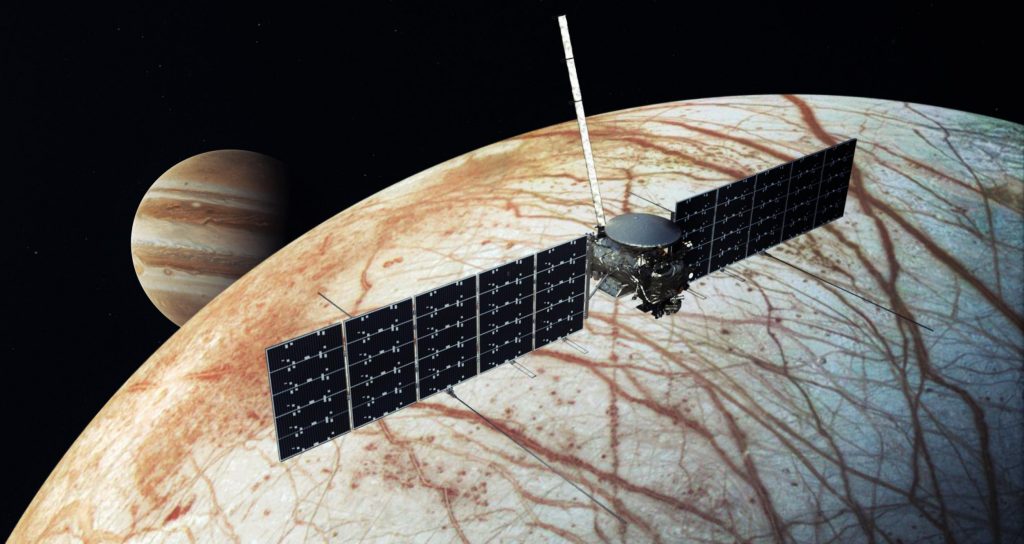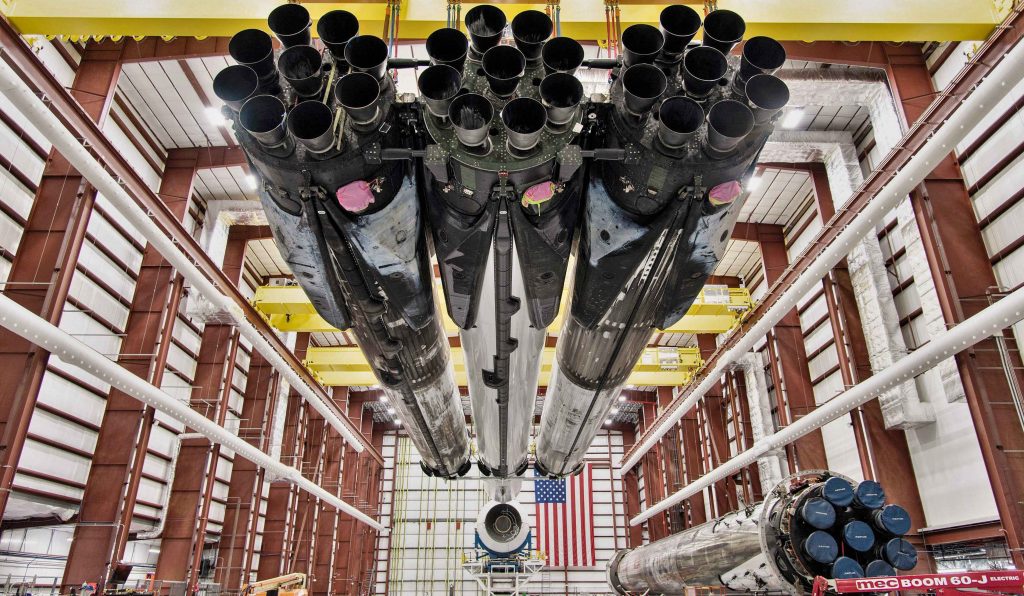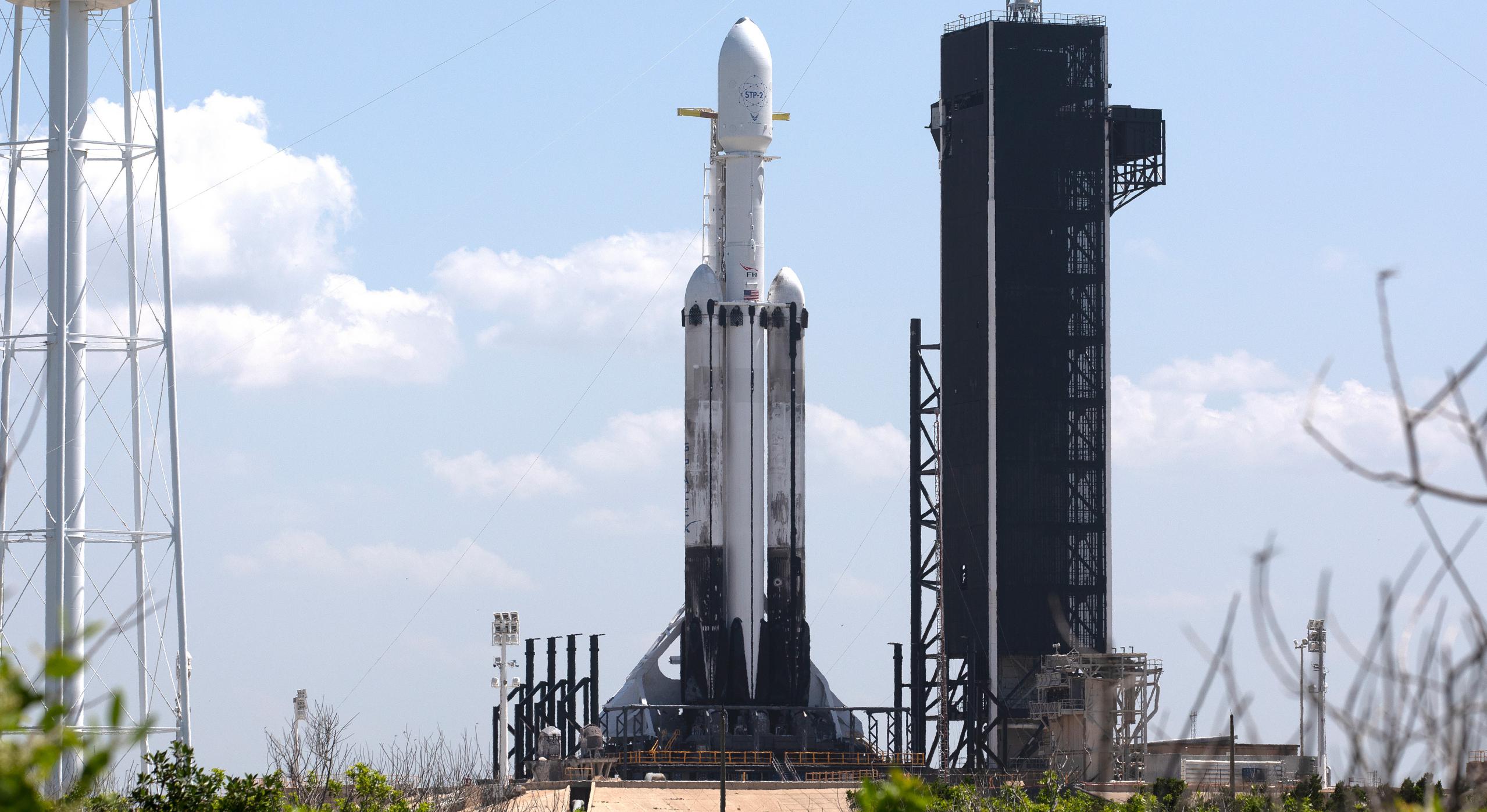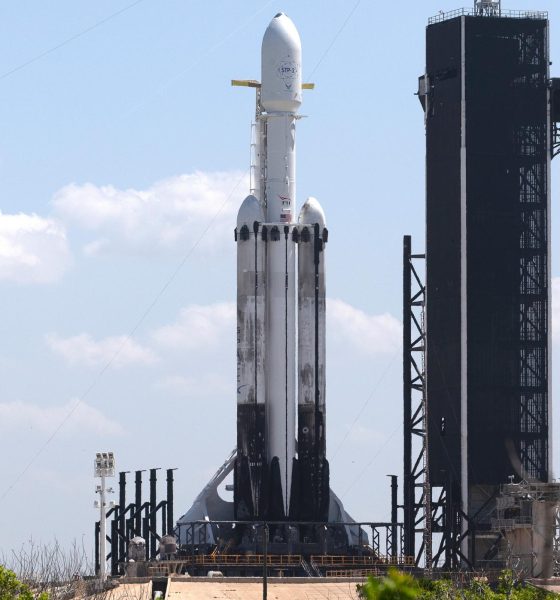Years before the space agency’s flagship Europa Clipper mission is scheduled to lift off, NASA and SpaceX are already determining the specifics of the launch – including which Falcon Heavy boosters will support it.
On July 23rd, 2021, after years of rumors, NASA officially announced that it no longer planned to launch Europa Clipper on its own SLS rocket and would instead contract with SpaceX to send the spacecraft to Jupiter on a Falcon Heavy. In terms of sheer prestige, no other mission on Falcon Heavy’s manifest comes close. Expected to weigh around six tons (~13,000 lb), Europa Clipper is a building-sized spacecraft that aims to orbit Jupiter for years, performing dozens of flybys of the planet’s icy moons – several of which almost certainly have liquid oceans.
Europa – the mission’s namesake – is its primary focus and whether or not the funding or political motivation for such an ambitious mission transpires, Europa Clipper was always partially meant to be a scouting mission for a nuclear-powered lander. On its own, though, Clipper has already blown past its original $2B budget target from 2013 and is now on track to cost more than $4.5B, making it the most expensive NASA mission currently in development – second only to the ~$9B James Webb Space Telescope (JWST). In other words, NASA is entrusting SpaceX to launch what is perhaps the most expensive mission to the outer solar system in the history of planetary exploration.

That makes it all the more noteworthy that NASA has already given the okay for SpaceX to plan to launch Europa Clipper on a Falcon Heavy rocket with at least two of its three boosters already flight-proven. According to mission scientist Bob Pappalardo, Clipper Mission Design Lead Brett Buffington revealed in spacecraft “System Integration Review” that SpaceX intends to reuse two Falcon Heavy side boosters that are currently scheduled to debut as early as next year on a different NASA mission. Known as Psyche, that mission – also scheduled to fly on Falcon Heavy – is scheduled to launch no earlier than (NET) August 2022 and is designed to explore an asteroid that’s believed to be almost entirely composed of metal.
With Europa Clipper scheduled to launch NET October 2024, that undoubtedly makes this the earliest a Falcon booster assignment has ever been confirmed – and probably the earliest SpaceX itself has assigned flight-proven boosters to a specific mission. It also makes those particular boosters quite special. Unlike Psyche, which will leave plenty of margin for SpaceX to recover at least two of Falcon Heavy’s three boosters, Europa Clipper will need almost every ounce of performance the rocket can give to send the much larger spacecraft much faster and further. Barring a major surprise, that means that Falcon Heavy will launch Europa Clipper in a fully expendable configuration.
For SpaceX, being able to use at least two flight-proven proven boosters on that expendable mission will make expending two Falcon Heavy boosters – which are otherwise capable of launching at least ten times in their lifetimes – a much easier pill to swallow. For NASA, the space agency is likely already familiar with the reality that flight-proven hardware actually improves schedule confidence, which is crucial for a mission like Europa Clipper thanks to its 21-day launch window.
Nonetheless, it does still raise the question of whether NASA will allow SpaceX to fly Psyche’s Falcon Heavy side boosters once or even twice more in the more than two years they’ll otherwise have to spend in storage between Psyche and Europa Clipper. A Falcon Heavy rocket is currently scheduled to launch a commercial Moon lander and NASA’s VIPER Moon rover as early as Q4 2023. Most recently, NASA purchased a Falcon Heavy to launch NOAA’s GOES-U weather satellite NET Q2 2024. In 2022 alone, SpaceX also has at least three other non-NASA missions scheduled to launch before Psyche, raising another possibility that Psyche itself might fly on once-flown boosters that would then fly a third, fourth, or even fifth time with Europa Clipper.

That might seem like an unlikely possibility but NASA has already shown that it’s happy to launch Cargo Dragons on boosters with multiple non-NASA missions in their pasts and will soon launch DART – an asteroid impact spacecraft – on another Falcon booster that last launched Starlink satellites. Additionally, with Arabsat 6A and STP-2, SpaceX already demonstrated in 2019 that it can launch Falcon Heavy, recover its two side boosters, and relaunch those same boosters on a different Falcon Heavy mission less than two months later – and for the US military, no less.

News
Tesla FSD fleet is nearing 7 billion total miles, including 2.5 billion city miles
As can be seen on Tesla’s official FSD webpage, vehicles equipped with the system have now navigated over 6.99 billion miles.

Tesla’s Full Self-Driving (Supervised) fleet is closing in on almost 7 billion total miles driven, as per data posted by the company on its official FSD webpage.
These figures hint at the massive scale of data fueling Tesla’s rapid FSD improvements, which have been quite notable as of late.
FSD mileage milestones
As can be seen on Tesla’s official FSD webpage, vehicles equipped with the system have now navigated over 6.99 billion miles. Tesla owner and avid FSD tester Whole Mars Catalog also shared a screenshot indicating that from the nearly 7 billion miles traveled by the FSD fleet, more than 2.5 billion miles were driven inside cities.
City miles are particularly valuable for complex urban scenarios like unprotected turns, pedestrian interactions, and traffic lights. This is also the difference-maker for FSD, as only complex solutions, such as Waymo’s self-driving taxis, operate similarly on inner-city streets. And even then, incidents such as the San Francisco blackouts have proven challenging for sensor-rich vehicles like Waymos.
Tesla’s data edge
Tesla has a number of advantages in the autonomous vehicle sector, one of which is the size of its fleet and the number of vehicles training FSD on real-world roads. Tesla’s nearly 7 billion FSD miles then allow the company to roll out updates that make its vehicles behave like they are being driven by experienced drivers, even if they are operating on their own.
So notable are Tesla’s improvements to FSD that NVIDIA Director of Robotics Jim Fan, after experiencing FSD v14, noted that the system is the first AI that passes what he described as a “Physical Turing Test.”
“Despite knowing exactly how robot learning works, I still find it magical watching the steering wheel turn by itself. First it feels surreal, next it becomes routine. Then, like the smartphone, taking it away actively hurts. This is how humanity gets rewired and glued to god-like technologies,” Fan wrote in a post on X.
News
Tesla starts showing how FSD will change lives in Europe
Local officials tested the system on narrow country roads and were impressed by FSD’s smooth, human-like driving, with some calling the service a game-changer for everyday life in areas that are far from urban centers.

Tesla has launched Europe’s first public shuttle service using Full Self-Driving (Supervised) in the rural Eifelkreis Bitburg-Prüm region of Germany, demonstrating how the technology can restore independence and mobility for people who struggle with limited transport options.
Local officials tested the system on narrow country roads and were impressed by FSD’s smooth, human-like driving, with some calling the service a game-changer for everyday life in areas that are far from urban centers.
Officials see real impact on rural residents
Arzfeld Mayor Johannes Kuhl and District Administrator Andreas Kruppert personally tested the Tesla shuttle service. This allowed them to see just how well FSD navigated winding lanes and rural roads confidently. Kruppert said, “Autonomous driving sounds like science fiction to many, but we simply see here that it works totally well in rural regions too.” Kuhl, for his part, also noted that FSD “feels like a very experienced driver.”
The pilot complements the area’s “Citizen Bus” program, which provides on-demand rides for elderly residents who can no longer drive themselves. Tesla Europe shared a video of a demonstration of the service, highlighting how FSD gives people their freedom back, even in places where public transport is not as prevalent.
What the Ministry for Economic Affairs and Transport says
Rhineland-Palatinate’s Minister Daniela Schmitt supported the project, praising the collaboration that made this “first of its kind in Europe” possible. As per the ministry, the rural rollout for the service shows FSD’s potential beyond major cities, and it delivers tangible benefits like grocery runs, doctor visits, and social connections for isolated residents.
“Reliable and flexible mobility is especially vital in rural areas. With the launch of a shuttle service using self-driving vehicles (FSD supervised) by Tesla in the Eifelkreis Bitburg-Prüm, an innovative pilot project is now getting underway that complements local community bus services. It is the first project of its kind in Europe.
“The result is a real gain for rural mobility: greater accessibility, more flexibility and tangible benefits for everyday life. A strong signal for innovation, cooperation and future-oriented mobility beyond urban centers,” the ministry wrote in a LinkedIn post.
News
Tesla China quietly posts Robotaxi-related job listing
Tesla China is currently seeking a Low Voltage Electrical Engineer to work on circuit board design for the company’s autonomous vehicles.

Tesla has posted a new job listing in Shanghai explicitly tied to its Robotaxi program, fueling speculation that the company is preparing to launch its dedicated autonomous ride-hailing service in China.
As noted in the listing, Tesla China is currently seeking a Low Voltage Electrical Engineer to work on circuit board design for the company’s autonomous vehicles.
Robotaxi-specific role
The listing, which was shared on social media platform X by industry watcher @tslaming, suggested that Tesla China is looking to fill the role urgently. The job listing itself specifically mentions that the person hired for the role will be working on the Low Voltage Hardware team, which would design the circuit boards that would serve as the nervous system of the Robotaxi.
Key tasks for the role, as indicated in the job listing, include collaboration with PCB layout, firmware, mechanical, program management, and validation teams, among other responsibilities. The role is based in Shanghai.
China Robotaxi launch
China represents a massive potential market for robotaxis, with its dense urban centers and supportive policies in select cities. Tesla has limited permission to roll out FSD in the country, though despite this, its vehicles have been hailed as among the best in the market when it comes to autonomous features. So far, at least, it appears that China supports Tesla’s FSD and Robotaxi rollout.
This was hinted at in November, when Tesla brought the Cybercab to the 8th China International Import Expo (CIIE) in Shanghai, marking the first time that the autonomous two-seater was brought to the Asia-Pacific region. The vehicle, despite not having a release date in China, received a significant amount of interest among the event’s attendees.










